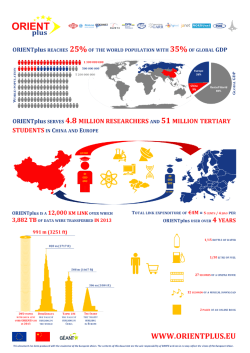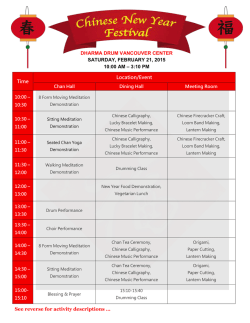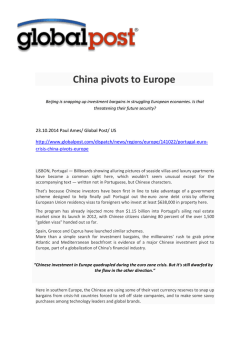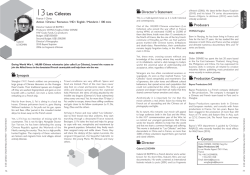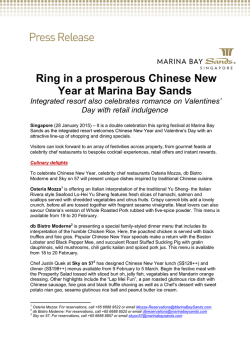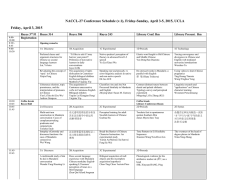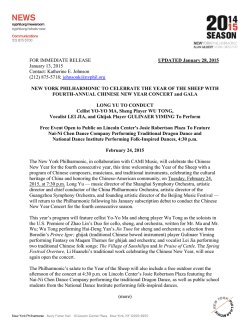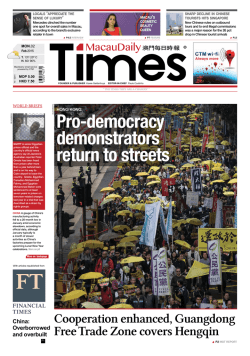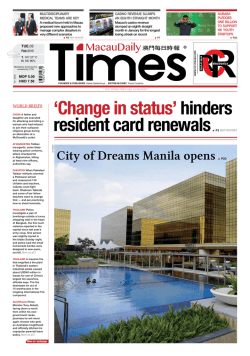
Chinas Shadow Foreign Policy - Mercator Institute for China Studies
China’s Shadow Foreign Policy: Parallel Structures Challenge the Established International Order By Sebastian Heilmann, Moritz Rudolf, Mikko Huotari and Johannes Buckow EXECUTIVE SUMMARY © China’s foreign policy is working systematically towards a realignment of the international order through establishing parallel structures to a wide range of international institutions. China has taken on a key role in financing these alternative mechanisms that are designed to increase China’s autonomy visà-vis U.S.-dominated institutions and to expand its international sphere of influence. infrastructure projects, security policy, technology (in particular ICT standards and internet regulation), and informal diplomatic forums. With a network of China-centred organizations and mechanisms, China is strategically targeting gaps within established intergovernmental structures. This network includes marginalised countries that are seeking out new partners for international development assistance and their foreign relations. Current challenges to the post-cold war order such as the Ukraine crisis and the protracted reform blockades in the WTO, the IMF, and the World Bank are favouring China’s shadow foreign policy. China’s multiple initiatives are most effective when they are promoted in combination with one another. Novel funding and currency mechanisms have developed a significant attraction in Asia, Africa, and Latin America within a short period of time. In Central Asia, China’s efforts to reshape the regional security architecture overlap with large-scale and generously funded infrastructural projects. China continues to be involved in existing institutions. Chinese foreign policy is not seeking to demolish or exit from current international organizations and multilateral regimes. Instead, it is constructing supplementary — in part complementary, in part competitive — channels for shaping the international order beyond Western claims to leadership. The evolving Chinese-sponsored organizations and mechanisms have the potential to challenge and constrain American and European predominance in important international institutions and policy areas. Efforts at keeping China at bay in international rule-making for the 21st century, however, will almost certainly backfire and reinforce Chinese determination to build alternatives structures. Instead, a cautious involvement and participation in selected mechanisms (such as the AIIB or the Silk Road Economic Belt) that address pressing needs in the targeted regions, should be considered in Western capitals. Otherwise important new areas of international engagement will be left to Chinese initiative and control. The parallel structures fostered by China stretch across a variety of areas. Financial and currency policy, trade and investment, transregional Illustration 1: International Parallel and Alternative Structures Promoted by China © 1 Introduction While current crises in the Ukraine, Syria, Iraq and West Africa have moved to the centre of global attention, China is advancing with a restructuring of the international order. While Beijing remains an active player within existing international institutions, it is simultaneously promoting and financing new parallel structures. The goal of these efforts is a greater autonomy primarily vis-à-vis the U.S. and an expansion of the Chinese sphere of influence beyond Asia. Chinese foreign policy seeks to adapt international organizations and diplomatic forums to the growing weight of China and other BRICS-states as well as to the relative loss of power of the U.S. and Europe. China is identifying gaps in the international order and filling them with its own initiatives. Some of these parallel structures, however, may also come to compete directly with existing institutions. The deepening and networking of these structures is still in its initial phase. But current international tensions accelerate the expansion of the new mechanisms promoted by China and increase their attractiveness among developing and emerging countries. Already today, novel China-centered structures with varying degrees of coverage and sophistication can be identified over a broad spectrum of policy areas: © - financial and monetary policy trade and investment transregional infrastructure projects security policy technology, in particular ICT diplomatic forums. Typical of many of these initiatives, China is engaged in an “infrastructural foreign policy.” The most advanced external undertakings are driven forward by Chinese capabilities in constructing physical infrastructure, especially railways, roads, electricity, and telecommunication networks in regions of the world that have been, or have felt, neglected by multilateral and Western development assistance in the past. Chinese efforts also encompass the build-up of financial and cyber infrastructures that are designed to provide greater autonomy from Western predominance in these realms. 2 Financial and Monetary Policy The financial structures advanced by China duplicate in part the Bretton-Woods institutions (IMF and World Bank) or serve to internationalize the Chinese currency (Renminbi, RMB). In addition, companies such as UnionPay or United Credit Rating Agency are currently challenging the monopoly position of U.S. credit card companies (VISA, MasterCard) and rating agencies (Moody's, Fitch, S&P). 2.1 Internationalization of the Renminbi (RMB) The Chinese government is striving towards a controlled internationalization of China's currency through a step-by-step expansion of the use of the RMB in Chinese foreign trade and investment. Towards this end, a worldwide network of agreements dealing with central bank currency swaps, the direct exchange of the RMB with other currencies, and RMB clearing hubs has been built. The establishment of an independent payment system (CIPS) for RMB transactions and an alternative to the existing SWIFT would further increase China’s autonomy vis-à-vis U.S. centred financial market structures. The expansion of Shanghai into a global financial centre has a central role in China's external economic relations. Chinese foreign trade and financial policies are advancing the RMB's internationalization in cautious, explorative steps. The declared goal is to limit the function of the U.S. dollar as a globally predominant reserve currency and to work towards a multi-polar global monetary order that rests on several lead currencies, including the dollar, the Euro, the RMB and others. Table 1: Parallel Structures Promoted by Chinese Foreign Policy in Important Policy Areas China-Centered Organizations and Mechanisms Key Features Parallel to: BRICS New Development Bank (NDB) 金砖国家新发展银行 Development bank with a focus on infrastructure, founded in July 2014 with headquarters in Shanghai; Indian presidency for the first five years. World Bank, regional development banks Asian Infrastructure Investment Bank (AIIB) 亚投行 / 亚洲基础设施投资银行 Initiative announced in Oct 2013 (APEC summit), with an initial capital injection of 50 billion USD; all ADB members were invited to join in; 20 founding countries (as of Oct 2014). ADB BRICS Contingency Reserve Arrangement (CRA) 金砖国家应急储备基金 Chiang Mai Initiative Multilateralization (CMIM); 清迈倡议多边化; ASEAN+3 东盟 +3; Asian Macroeconomic Research Office (AMRO) 宏观经济研究办公室 Reserve pool (100 billion USD) for crisis liquidity (signed in July 2014) IMF Reserve pool (increase to 240 billion USD in effect since July 2014) for crisis liquidity (“Multilateralization” started in March 2010; AMRO established in April 2011, status as International Organization since October 2014) IMF, EMEAP, (BIS) Mechanisms for internationalizing the RMB Ten agreements on direct exchange of RMB with other currencies; treaties on clearing banks in nine countries; seven country-specific RQFII quotas; 26 swap agreements with central banks. State Council decision (2012) to turn Shanghai into a global financial centre; approval of Shanghai FTZ (Aug 2013). RMB-denominated futures markets for crude oil, natural gas, petrochemicals (Aug 2014); gold trading platform (Fall 2014); six other international commodities futures markets are in the planning stage. Established currency market mechanisms Established centres for financial, commodities,and futures markets China International Payment System (CIPS) 人民币跨境支付系统 CIPS for international RMB transactions (April 2012); Sino-Russian negotiations on alternatives to SWIFT (fall 2014). Established payment systems (CHIPS etc.) Universal Credit Rating Group (UCRG) 世评集团 Joint project of three rating agencies (Dagong, RusRating, Egan-Jones) (since June 2013); NDRC and Foreign Ministry launch joint research project on preparing an Asian rating system (June 2014). S&P, Moody’s, Fitch China Union Pay (CUP) 中国银联 Association of card issuing banks (since 2002); currently accepted in 140 countries, issued in 30 countries, most recently: Russia (Aug 2014), Myanmar (Sep 2014). VISA, MasterCard Financial and Monetary Policy Shanghai as global financial center with RMB-denominated futures markets 上海金 融中心 Trade and Investment Policy Regional Comprehensive Economic Partnership (RCEP) 区域全面经济伙伴关系 A free trade agreement planned to be concluded by the end of 2015 and to encompass three billion people or 40 percent of world trade. TPP, TTIP Free Trade Area of the Asia Pacific (FTAAP) 亚太自由贸易区 China pushes feasibility study for a free trade agreement that would include most of the Pacific Rim. TPP © China-U.S. and China-EU bilateral investment treaties 中美投资协定, 中欧投 资协定 Nicaragua Canal 尼加拉瓜運河 Silk Road Economic Belt 丝绸之路经济带 Conference on Interaction and ConfidenceBuilding Measures in Asia (CICA) 亚洲相互 协作与信任措施会议 Shanghai Cooperation Organisation (SCO) 上海合作组织 International Telecommunications Union 国 际电信联盟 Two-stage approach to technological standards Domestic hardware, software, and encoding standards 硬件、软件编码标准 BRICS Summits 金砖国家峰会 Chinese regional forums Bo’ao Forum for Asia (BFA) 博鳌亚洲论坛 © Investment treaties intended to cover all sectors and phases of investments, including market access; intense negotiations (U.S.-China since May 2013; EU-China since Jan 2014). Transregional Infrastructure Projects Mega-project negotiated by a private Hong Kong-Chinese investor; construction to be undertaken in cooperation with Chinese state-controlled corporations; indirect support from Chinese and Russian governments (although China has no official diplomatic relations with Nicaragua). Large-scale infrastructural and geostrategic projects (announced by President Xi Jinping in November 2013) that aim at opening up new land and maritime trading corridors across Eurasia. Security A security forum originally initiated by Kazakhstan(1999); China serves as chair 2014-16. TTIP, TPP Panama Canal New Silk Road (U.S.), Eurasian Econ.Union (RUS) ARF An international organization (established in 2001) by China, Russia, Kazakhstan, Kirgizstan, Tadzhikistan and Uzbekistan with a security focus. In 2014, India, Iran, Pakistan applied for membership. Technology, in particular ICT Special organization of the UN originally responsible for international telecommunications. In 2012, China and Russia secured the expansion of the ITU’s authority to include Internet governance. CSTO, ARF Establishment and spread of domestic standards; domestic stage: protect Chinese ICT infant industries from foreign competition; globalization stage: profit from IPR in global markets. Chinese coding standards for digital communication (TD-SCDMA for mobile communications, WAPI for WiFi) and satellite navigation system (BeiDou) to prevent foreign domination of ICT markets, protect Chinese industries, contain cyber sabotage and espionage. Diplomatic Forums Association of originally four, now five emerging countries that have been holding summit meetings since 2008. A potential political alliance vis-à-vis Western industrial nations. Several forums primarily with a focus on economy, trade, and infrastructure: China-Arab States Cooperation Forum, Forum on China-Africa Cooperation (中非合作论坛), China-CELAC Forum (中国 -阿拉伯国家合作论坛), Asia Cooperation Dialogue (亚洲合作对话). Foreign technology standards U.S.-dominated global cyber-infrastructure An annual forum founded in 2001 for decision-makers from politics, business, and academia with a regional focus on Asia. WEF/Davos WSIS-forum (strong role of private sector, NGOs) G7/G8 Regional forums founded with U.S. or EU initiative 2.2 Providing Crisis Liquidity Alternative mechanisms for providing crisis liquidity have already reached a stage of institutionalization. Partially in competition with the IMF, these include the East Asian Chiang Mai Initiative Multilateralization (CMIM), a 240 billion dollar reserve pool, and accompanying “surveillance” activities by the ASEAN+3 Macro-economic Research Office (AMRO). Over the medium term, local currencies, including the RMB, are intended to play an increasingly important role in the CMIM framework. The BRICS Contingency Reserve Arrangement (finalized in July 2014) was modelled on CMIM, but it is financially less well-endowed. China plays a leading role in both institutions, in the case of CMIM on eyelevel with Japan. 2.3 Competition with Multilateral Banks Under Chinese initiatives, increasing competition is emerging for existing multilateral development banks, in particular the World Bank and the Asian Development Bank (ADB). It is a striking feature of both the BRICS New Development Bank (NDB) and the Asian Infrastructure Investment Bank (AIIB) that they will concentrate on funding infrastructure projects. With these new shadow institutions, a direct alternative and challenge to the 70 years-old Bretton Woods system is being established. China © will thus be able to introduce new priorities, principles and procedures for multilateral development assistance. 3 Trade and Investment Policy In trade and investment policy, the search for bilateral or regional alternatives to existing structures is not a new development. China’s efforts can be seen as a response to the standstill at the WTO's Doha Round and to U.S. trade policy. From a Chinese perspective, in order to defend its predominant role in the global economy, the U.S. is excluding China from rule-making in international trade policy. Chinese diplomats and academics specifically point to the Transpacific Partnership (TPP) and the Transatlantic Trade and Investment Partnership (TTIP) that have the potential to establish standards for global trade in the 21st century while excluding China, the world’s biggest goods trading nation. 3.1 Abolishing Barriers to Regional Trade Regional initiatives, where China can bring its own interests into the negotiation process, include the proposed Regional Comprehensive Economic Partnership (RCEP), a trilateral agreement between China, Japan, and South Korea, and the envisioned Free Trade Area of the Asia Pacific (FTAAP). RCEP, initiated by ASEAN in November 2011 (based on a joint Japanese-Chinese proposal in August 2011) can be seen as an implicit counterinitiative to TPP. It would include the ten states of ASEAN and the six states with which ASEAN already has signed free trade agreements (Australia, China, India, Japan, South Korea, and New Zealand). The conclusion of negotiations is ambitiously set for the end of 2015. The free trade zone would encompass an economic area that generates a large portion of global economic growth Furthermore, China has been backing the call for a feasibility study on an even more ambitious Free Trade Area of the Asia Pacific (FTAAP). This economic area is supposed to encompass the Pacific Rim states, but would require agreement between the United States, Russia, and China (which currently seems highly unlikely). 3.2 Bilateral Free Trade Agreements These regional multilateral efforts are complemented by a comprehensive network of bilateral free trade agreements (FTAs). China has to date signed 11 FTAs (with the ASEAN states, Pakistan, Chile, New Zealand, Singapore, Peru, Hong Kong, Macau, Costa Rica, Iceland, and Switzerland). Until the end of 2014, negotiations with Sri Lanka, Australia, and South Korea are scheduled for completion. Moreover, China is currently engaged in wideranging and tough negotiations on bilateral investment treaties with both the U.S. and the EU. As to EU-China trade relations, China is even pressing for a feasibility study about a full-scale FTA. But the EU keeps rejecting this proposal, pointing out that the economic and legal commitments involved in an FTA are much more demanding and difficult to implement than the commitments of a more narrowly conceived investment agreement. For this reason, the EU argues that an investment agreement must precede any possible future FTA. 4 Transregional Infrastructure Projects The "Silk Road Economic Belt" initiative, announced by Xi Jinping in 2013, is a key geostrategic project in building up parallel structures. The primary goal is to create novel Eurasian transport and trade infrastructures. A second step would be removing barriers to free trade. The Silk Road initiative serves the diversification of Chinese trade routes and an expansion of China's geostrategic power. Alongside security concerns in Central Asia, energy interests, the opening of new © markets, and lower transportation costs in foreign trade with Europe all play a role for China. The Chinese Silk Road plans, however, compete with other Central Asian strategies, especially the Russia-initiated Eurasian Economic Union and the U.S.-initiated New Silk Road Initiative. Both, however, have much fewer resources to offer than the investment-driven and shovel-ready Chinese undertakings. Beyond the Central Asian corridor, the Chinese government is also pushing with great impetus the initiative of a "Maritime Silk Road", which would stretch from Southeast China to Europe via the Iraqi port of Basra. The ports built by Chinese statecontrolled corporations in the Indian Ocean (in Sri Lanka, Burma, Pakistan) could serve as important transport hubs. Linkages between individual points on the land route and the maritime route also seem possible. Chinese companies are already involved in planning and building railroads that eventually may connect Central Asia to the Persian Gulf. As an irritation to the U.S. and the Panama Canal Authority, Chinese investors have for several years shown a lively interest in an alternative to the Panama Canal. The "Nicaragua Canal" project whose construction is scheduled to begin in December 2014, is publicly promoted by a Hong Kong-based investor and is supposed to be undertaken in cooperation with Chinese statecontrolled construction companies. Since China does not entertain diplomatic relations with Nicaragua, the Chinese government has not played an open, visible role in the negotiations. 5 Security Policy China is engaged in expanding cooperation mechanisms to face regional security challenges, in particular terrorism, separatism, and extremism, as defined by the Chinese government. The Conference on Interaction and ConfidenceBuilding Measures in Asia (CICA, originally a Kazakh initiative that resulted in first ministerial meetings in 1999) and the Shanghai Cooperation Organisation (SCO, founded in 2001) are not poised against external actors like NATO. Instead, they are based on the idea that Asian states need to solve the security issues of the region on their own. CICA came to public attention with the summit in Shanghai (May 20-21, 2014). Russian President Putin and Xi Jinping joined in urging the establishment of a new regional security architecture. China will hold the chairmanship of CICA until 2016 and will continue to promote this agenda. At the 14th SCO summit in Dushanbe (Sep 11-12, 2014) Xi Jinping announced his desire to strengthen the SCO and to expand coordination with the CICA. In the run up to the summit, Iran, India, and Pakistan submitted a formal application for membership in the SCO. The acceptance of India and Pakistan can be expected in 2015. The security situation in Afghanistan (a country with SCO observer status) was a central point of discussion at the latest SCO summit. After NATO withdrawal, Afghanistan might in future call for SCO assistance. Despite increasing exchanges and military manoeuvres, the coordination and integration level of the SCO has remained low up to date. Over the mid-term, the development of the SCO will be affected by tensions in Chinese-Russian relations. Through its massive activities and investments China is challenging Russia’s historical hegemonic role in Central Asia. 6 Technology, Especially ICT Chinese industrial policy seeks to push for Chinese technology standards around the world in important high-tech realms. National standards serve initially to make Chinese companies less dependent on foreign patents and licensing. Thus, key domestic sectors and companies (including Huawei and Alibaba) have been protected from relying on or competing with foreign giants at an infant stage. Furthermore, setting indigenous ICT standards is supposed to make China independent of Americandominated cyber infrastructures. © 6.1 Exporting Chinese Technology Standards The global spread of Chinese technology standards is promoted by state-supported exports. In Africa, Chinese flagship companies like Huawei or ZTE have been building up entire national telecommunications infrastructures for years. It is also likely that China is providing its partners, some under authoritarian rule, with means for controlling the media and the Internet. 6.2 International Internet Regulation In international organizations, China is promoting state control of the Internet. In 2012, the Chinese and Russian initiative to expand the regulatory domain of the International Telecommunications Union (ITU) to the Internet was successful. This weakened the position of the World Summit of Information Society (WSIS) in which the private and non-profit sectors have a strong voice. 7 Diplomatic Forums China is increasingly using multilateral forums to expand its influence, especially in its relations to developing and emerging countries. Using the framework of the G20, the PRC seeks increased representation of emerging economic powers especially in international financial institutions. The coordination of emerging powers in the BRICS framework is supplemented with a network of regional forums that were initiated by China and serve to raise China's profile in Africa, Asia, and Latin America. China has initiated and supported financially the Forum of China-Africa Cooperation, the China-CELAC-Forum (Latin America), and the China-Arab States Forum. These activities mirror regional forums that were co-founded by the U.S. and the EU in the past. Furthermore, China represents its interests at informal summits like the Bo’ao Forum, which meets annually, and is modelled on the Davos World Economic Forum. 8 Conclusion Current challenges to the U.S.-dominated postCold War setting, from Ukraine to the Middle East, favour the expansion of parallel structures on the part of Chinese foreign policy. Russia, isolated from the West, serves as an important partner for China in these endeavours. Chinese initiatives will have the greatest impact where linkages between large infrastructural projects and novel funding schemes can be created. This will be the core mission of the newly founded Asian Infrastructure Investment Bank. By expanding transregional transport corridors beyond Asia, China integrates the surrounding states diplomatically and includes them in security cooperation through CICA and SCO. Already today, China’s international currency and financial initiatives are contributing to striking changes in global financial and monetary order. In this realm, competition from China-centred parallel mechanisms is already palpable and weakens the once dominant position of Western currencies and Western-led international organizations. Contact: Mikko Huotari [email protected] Imprint: Mercator Institute for China Studies Klosterstraße 64 10179 Berlin Tel: +49 30 3440 999 – 0 Mail: [email protected] www.merics.org ©
© Copyright 2025
